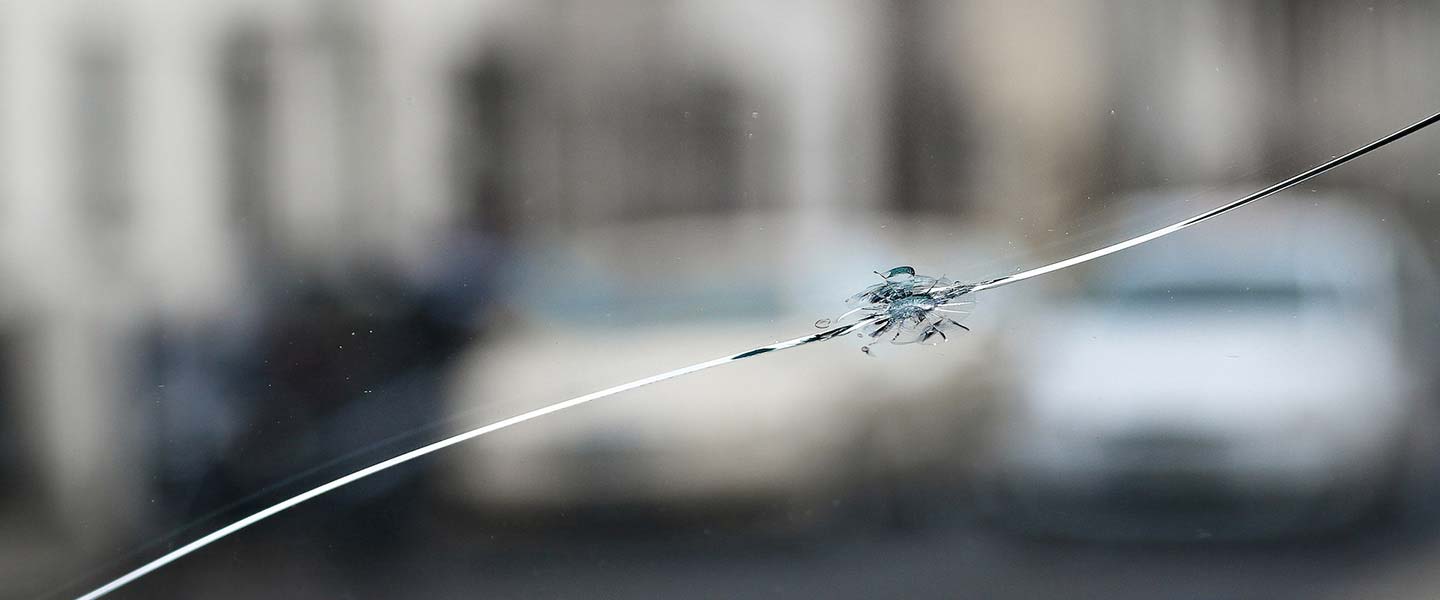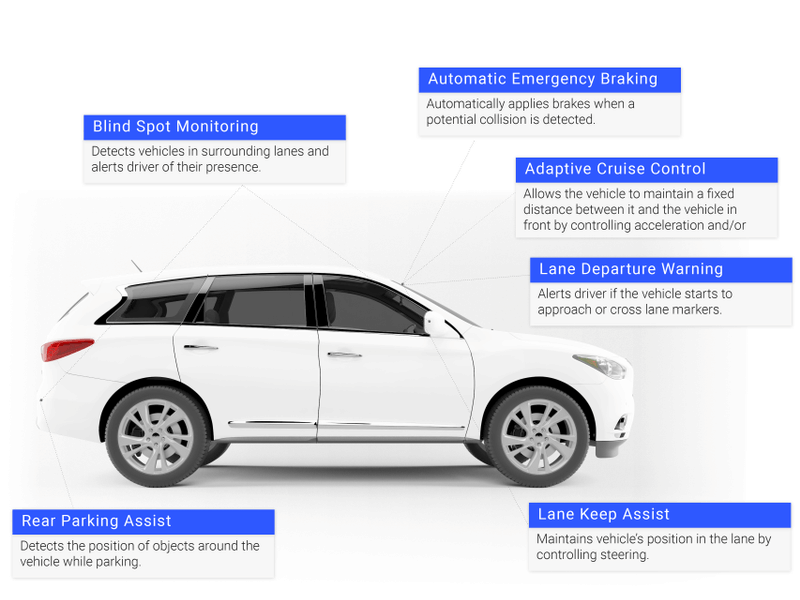Why Your Windshield is So Expensive
It's surprisingly easy to damage your windshield. One piece of gravel when you're driving behind a truck on the highway is all it takes. The Cost of Windshield Replacement in 2021 might surprise you.
Posted: 08/25/2021
Automotive

Visit pretty much any car dealership in 2020, and more than likely you'll notice that every new vehicle on the lot comes with at least one driver assistance feature built in. The features may go by different names, but things like a rear view camera to help with parking, or adaptive cruise control that automatically adjusts your speed for you depending on traffic are becoming common even in entry level vehicles.
There's no question that these features are a great thing for everyone on the road. Experts estimate that these features have already decreased the number of collisions causing injury by 27%.
But while these features are great for safety, they come at a cost. In this case, this cost shows up in the form of unexpected repair bills for what would otherwise be considered minor damage. Things like a damaged bumper or cracked windshield are now costing drivers more than ever, and it's all because of the advanced technology that drives these life-saving features.
What is ADAS?
ADAS (which stands for Advanced Driver Assistance System) is the general term for the electronic systems that are integrated into your vehicle to help you drive and park more safely. Common examples you may be familiar with are things like lane-keep assist, pedestrian collision avoidance, adaptive cruise control, etc. If you want to learn more about ADAS, we suggest this resource.
While there are sensors all over the car that are driving up repair costs, the rising cost of windshield replacement is especially surprising (and painful) for most drivers. Windshield replacement is one of the most common insurance claims made by drivers, and depending on where you live, a damaged windshield may be all too familiar.
Why Your Windshield is Expensive
It's surprisingly easy to damage your windshield. One piece of gravel when you're driving behind a truck on the highway is all it takes. For a relatively everyday occurrence, most of us would be pretty surprised to get the repair bill.
But the reason why your windshield is so expensive to replace in 2020 is actually a pretty good one. A lot of the sensors that power the ADAS features we mentioned earlier are located directly behind your windshield. This means that the windshield is no longer just responsible for protecting you from rain, rocks, and bug splatter - it's also protecting an advanced set of cameras and sensors that gives your car these potentially life-saving safety features.
Common Safety Features in Modern Vehicles:
Take a look at the infographic below to see exactly which systems rely on sensors that sit behind the windshield. Chances are, if your vehicle was manufactured in the past 4-5 years, you're familiar with a few of these.

Sensors the Power ADAS Features Need to be Calibrated
The good news is that your windshield usually does a pretty good job of protecting the sensors and cameras that the vehicle uses to power these ADAS features. But, when the windshield is replaced there is a risk that the sensors become misaligned in the process. Studies have shown that even a 1-degree change in a sensor's orientation can put you at risk, so the technician is required to do what's called a ‘recalibration' whenever the windshield is replaced.
This recalibration process requires a highly skilled technician and an expensive setup to ensure the sensors are interpreting the vehicle's environment correctly. This recalibration process is what drives up the cost of replacement, and typically adds at least $300 to the cost of the replacement service.
Calibrating the Sensors: Static vs. Dynamic Calibration
Well, the exact process for sensor recalibration really depends on the make and model of your vehicle. Auto manufacturers will provide a very specific set of instructions that the technician needs to use to properly perform the recalibration. While it can vary widely depending on the vehicle, there are typically two options for recalibration: static calibration and dynamic calibration.
Despite sounding like the simpler option, systems that need a static calibration are actually the more complicated procedure. While it doesn't require a technician to actually drive the vehicle on the road (which is why it's labelled "static"), the process requires a setup that can re-train the ADAS system to recognize targets positioned at different locations and distances away from the vehicle. To perform a static calibration, technicians need a large space where targets can be positioned at appropriate distances. The process can take as much as 3 hours to complete properly.
Dynamic (or on-road) calibration is actually less complicated. Vehicles that need dynamic calibration are driven around by the technician at a predetermined set of speeds and distances to retrain the car to recognize road markings and obstacles after the windshield is replaced. It's usually a little faster than the static process.
Because every major car manufacturer builds their ADAS system a little differently, whoever is replacing your windshield will need to know which method of calibration is necessary for your vehicle (some systems even need a combination of static and dynamic calibration).
It's also really important to make sure you're getting the recalibration done properly. While the systems are designed to keep you safe, even tiny misalignments can lead to disastrous consequences - we've even seen reports of drivers whose vehicles steered them into oncoming traffic after an incorrect recalibration. Choosing a technician for your windshield replacement that is reputable and has experience with the process is more important than ever.
Car Manufacturers Now Requiring the Use of OEM Glass
On top of the added costs because of the required recalibration costs, car manufacturers are increasingly requiring (or at least strongly encouraging) drivers to replace their windshield with OEM glass. While it may be tempting to look for a less expensive aftermarket alternative, there may be good reason to stick to OEM windshields for your ADAS-equipped vehicle.
Aftermarket vs OEM Windshields
OEM (Original Equipment Manufacturer) windshields are made by the manufacturer of your vehicle and will most closely resemble your original windshield. Keep in mind that most experts agree that the seal and quality of your original windshield can never be reproduced, even when you choose to pay for OEM windshield glass.
An aftermarket windshield is designed to fit your specific vehicle's make and model, but is not made by the original equipment manufacturer. In some cases, aftermarket glass may be of similar quality to OEM parts, but not always (it really depends on your vehicle and the aftermarket options available to you).
When it comes to cost, aftermarket windshields and replacement services are almost always going to come out cheaper. Just like any other vehicle repair, you'll often see a discount when you purchase 3rd party replacement parts and avoid going to your dealership.
Even if you've chosen affordable aftermarket options in the past, if your vehicle does have sensors behind the windshield it could be worth it to go for the OEM windshield. Many OEMs (Subaru, Volvo, and Honda are just a few examples) specifically recommend or require that technicians replace the windshield with an OEM part. They even claim that the technology behind the windshield could malfunction if you use an aftermarket glass replacement.
On top of that, due to the complicated nature of the calibration process, it may even be worth getting the repair done at the dealership where you can rest easy knowing the technicians replacing your windshield also specialize in recalibrating your OEM's ADAS system.
Ultimately the choice depends on lots of factors like your budget, comfort level, and specific vehicle. In any case, we recommend doing the research before booking your windshield replacement just to make sure you're keeping your own safety your top priority.
The Cost of Windshield Replacement in 2020
By you probably just want to know how much it would cost to replace your car's windshield. Well, this can depend on a few factors (which we'll get to), but in general most drivers can expect to pay easily over $1000 to replace their windshield - regardless of the type of vehicle they drive.
We took a look at the average windshield replacement costs for some of the more common vehicles:
| Vehicle | Year | Price |
|---|---|---|
| Toyota Camry | 2019 | $1,359 USD |
| Toyota Corolla | 2019 | $1,129 USD |
| Honda Civic | 2020 | $869 USD |
| Jeep Wrangler | 2020 | $1,149 USD |
| Nissan Sentra | 2020 | $1,409 USD |
| Tesla Model S | 2020 | $1,049 USD |
| BMW X5 | 2020 | $1,209 USD |
| BMW X3 | 2017 | $1,650 USD |
| Porsche 911 | 2019 | $2,110 USD |
| Audi A8 | 2019 | $1,009 USD |
Will insurance cover my windshield replacement?
If you're thinking that this doesn't apply to you because you have insurance coverage for windshield replacement well, first of all - lucky you! And second of all, that may not last long. While insurance coverage for windshield replacement varies widely depending on where you live (for example, some regions have mandatory comprehensive coverage), the insurance industry is still dealing with the effects that these safety systems are having on their claim rates.
In 2019, most auto insurance companies actually reported losses because of the high repair and replacement costs. You can bet that insurers won't be willing to operate at a loss for very long, which means that insurance premiums will almost certainly start to increase to compensate for higher claims.
What Options do you Have?
At the end of the day, the cost to replace a modern windshield is a lot higher than most people realize, and that's not likely to change anytime soon. The advanced safety features that are in most vehicles in 2020 are designed to keep us safer on the road, but are also costing us more when it comes to vehicle repairs. The best way to protect yourself from an expensive and unexpected windshield replacement expense is to simply protect your windshield.
To learn more about windshield protection for your vehicle, check out our available options.
This article is provided by Exoshield and originally posted:
https://www.getexoshield.com/blog/windshield-replacement-cost
Stay Up-to-Date
Be the first to know when we post something new! Get the latest information from MARS of Billings straight to your inbox.
Subscribe